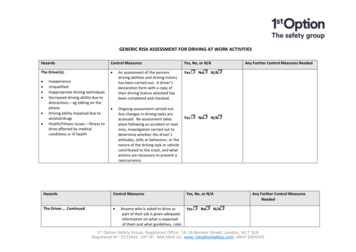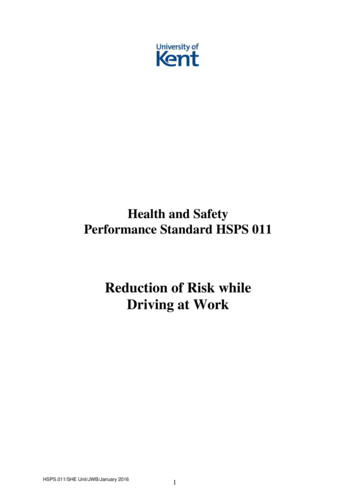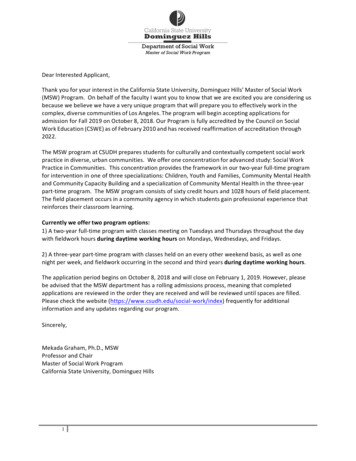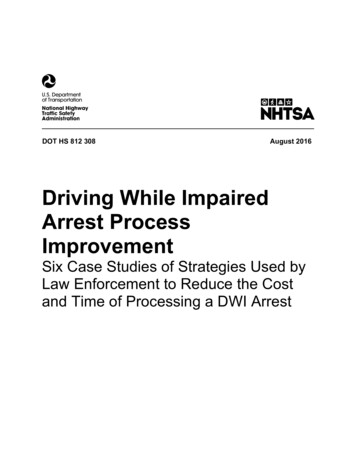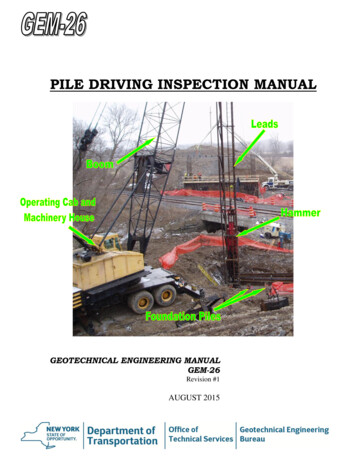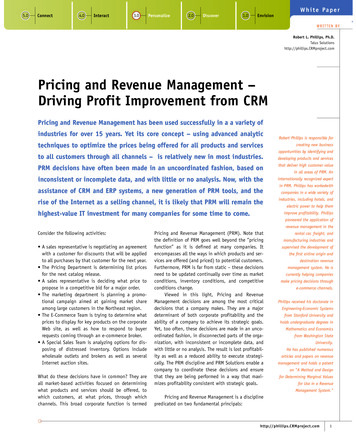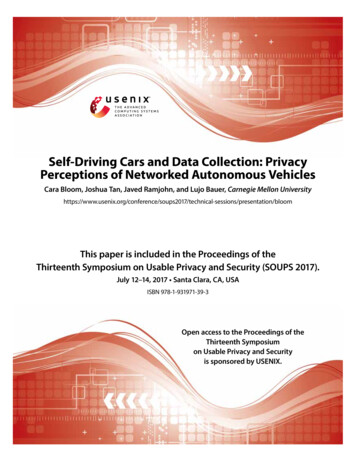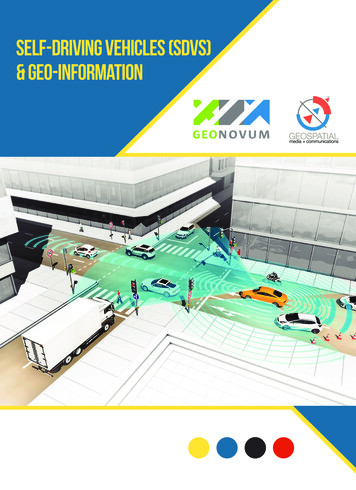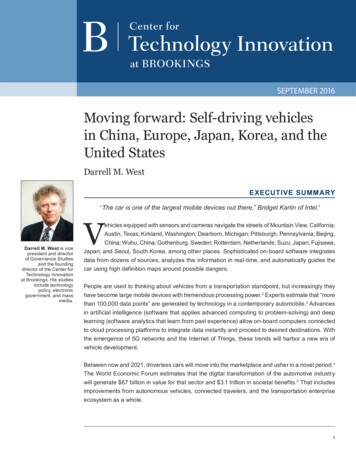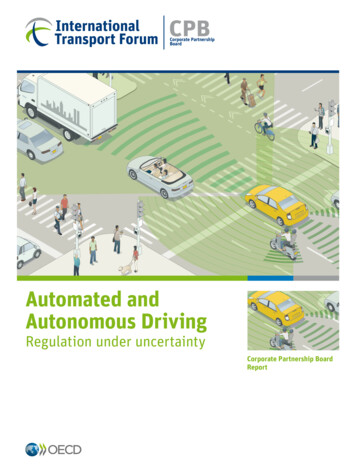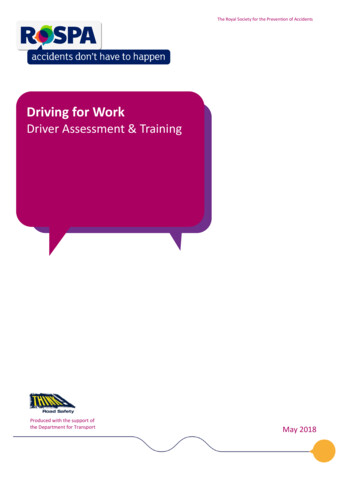
Transcription
The Royal Society for the Prevention of AccidentsDriving for WorkDriver Assessment & TrainingProduced with the support ofthe Department for TransportMay 2018
Driving for Work: Drive Assessment & TrainingIntroductionDriving is the most dangerous work activity that most people do, and it contributes to far more work-relatedaccidental deaths and serious injuries than all other work activities.Very few organisations can operate without using the road. Millions of vehicles (lorries, vans, taxis, buses,emergency service vehicles, company cars, motorcycles, bicycles) are used for work, and many people work onfoot on the road (maintenance workers, refuse collectors, postal workers, vehicle breakdown employees, thepolice and so on).Unfortunately, all these workers face risks on the road because they are doing their jobs. They can also createrisks for everyone else on the road. The HSE estimate that "more than a quarter of all road traffic incidentsmay involve somebody who is driving as part of their work at the time."Police road accident data shows that every year over 500 people are killed (almost one third of all roaddeaths), 5,000 seriously injured and almost 40,000 slightly injured in collisions involving drivers or riders whoare driving for work. This includes other road users, as well as at-work drivers and riders themselves. In fact,most of those killed on work-related journeys are passengers, pedestrians and riders rather than the at-workdrivers and riders.Employers have a duty to assess, train and supervise staff who drive as part of their job, and to manage theconditions under which staff drive for work, in order to reduce the risks their staff face and create when theydrive for work.HSE’S Driving at Work Guidelines state that“health and safety law applies to on-the-road work activities and the risks should beeffectively managed within a health and safety system.”Almost all road crashes are caused by, or involve, human error. The most frequently recorded causes of roadcrashes involving drivers are: careless, thoughtless, reckless drivinginappropriate speedfailure to look properlyloss of control of vehiclelack of judgement of own pathfailure to give waypoor turn or manoeuvreinattention or distractionThis guide gives simple advice on how employers and line managers can select, assess, train and supervise staffwho drive for work in order to reduce the risk that they face and create for others.1
Driving for Work: Drive Assessment & TrainingWhat employers can doMake sure that you put in place policies, people and procedures to enable you to understand: How your organisation uses the road (the staff who do so, the vehicles they use and the journeys theymake) The risks this creates to your staff and other people The potential consequences of those risks, and The measures needed to manage and reduce these risks and consequences.This will make your organisation more efficient and successful by helping you to: Keep your employees and volunteers safe while at work Protect other road users Save money by reducing crashes and incidents Reduce business interruptions Avoid adverse publicity associated with crashes Promote smoother driving which improves fuel efficiency and reduces environmental impact.Road crashes are not just caused by driver error, but also by the nature of the driving that at-work drivers arerequired to do (for example, their schedules, time pressures and distractions) and the vehicles they drive. SeeDriving for Work: Choosing Safer Vehicles.Take particular care to reduce risks caused by driver tiredness, distraction and time pressures, and to reducethe amount of driving as much as possible by: Using remote communications (telephone, email, video-conferencing, etc)Travelling by plane or train, which is far safer and more environmentally-friendly.Maximising car sharing to reduce the number of journeys.Provide driver assessment and trainingMake driver assessment and training part of the organisation’s overall policy andprocedures. Good driver assessment and training does not just focus on driving skills, but also on driver’sattitudes, knowledge and understanding of how they can manage driving risks. It also aims to ensure thatdrivers are aware of vulnerable road users, especially pedestrians, pedal cyclists and motorcyclists.It should also reflect the fact that at work drivers are not all the same. It is important to identify which driversare most at risk and why, so that the most appropriate intervention can be delivered. Accident risk varies,depending on the amount and type of work related driving, vehicles, driving skills and attitudes, age, genderand personal characteristics.Lead by ExampleSenior Managers, from the head of the organisation down, should lead by personal example and follow theguidance in this leaflet, both in the way they drive themselves and in encouraging colleagues to drive safely.Expect Safe DrivingMake sure that all your staff, including directors, senior managers and line managers, understand that they areexpected to drive safely, responsibly and legally. If they have concerns about the organisation’s driving policyor procedures, they should raise them with their line manager or staff representative.2
Driving for Work: Drive Assessment & TrainingEngage StaffEnsure that staff are fully consulted about the organisation’s policies on safe driving, including driverassessment and training. Review the policy periodically in joint health and safety committee meetings.Some drivers may find driver assessment or training intimidating or feel it is unnecessary,so clear and positive communication is important. The company’s image and reputationcan be affected, positively or negatively, by the way their staff drive, especially if driving aliveried vehicle. As part of recruitment, training and staff appraisal, remind drivers and linemanagers to understand that the company needs to: Assess each driver’s risk and competence, even though they have passed the driving testAssess drivers for the specific type of driving their job requiresAssess the sort of driving their job requiresIdentify those who are at the highest risk (due to their driving skills and attitudes and/or to the type ofdriving they do).Include driving issues in periodic staff appraisals and team meetings, and note any feedback from drivers andensure that it is addressed as necessary.Check Driver LicencesConduct regular driver licence checks, at least once a year, but more often for high mileage drivers or thosewith a poor driving record. An easy way of tracking endorsements is to check driving licences (at appointmentand regularly afterwards); the most cost-effective way of doing this is usually via the DVLA’s online checkingfacility (each driver must sign a mandate allowing you to do this).Check Business Use Motor InsuranceCheck that staff who drive for work (including those who use their own vehicle for work journeys) havebusiness use cover on their insurance.Consider a Permit to DriveMany organisations operate a ‘permit to drive’ system in which only staff who have been authorised to do soare allowed to drive on company business; sometimes it is a condition of the company’s insurance.Train Line ManagersTrain managers to manage work related road safety as part of their health and safety responsibilities, and tolead by personal example by following the organisation’s policy. They should understand the importance ofdriver assessment and training, their role in ensuring that it is properly implemented for all the drivers theymanage, to understand how to use the results from driver assessments and training to prioritise those driverswho are at highest risk, and to make any necessary management changes, such as journey planning, schedules,and so on.Assess and Train Your DriversAssess drivers’ attitudes and their driving competence on recruitment, during induction and regularlyafterwards, including fitness to drive, with their drivers during periodic staff appraisals and team meetings.Assess all drivers regularly, but prioritise those with the greatest mileages, young drivers, drivers using a newtype of vehicle, such as a van, and drivers with a crash history or history of motoring offences. Use the resultsto identify training needs and other risk management measures, and discuss driving during individual staffappraisals, and group meetings. Provide driver education and practical training for your drivers, based on theneeds identified through driver assessment and targeting those at greatest risk first.3
Driving for Work: Drive Assessment & TrainingWhen to Assess and TrainAssessment and training should take place at various points during a person’s career with the company,starting with their recruitment and continuing at regular intervals. On RecruitmentIf a job involves driving, recruitment should include questions about applicants’ driving abilities and history(amount and type of driving experience, accidents and motoring offences) and a driving licence check.Consider requiring applicants to take a: Driver profiler assessment to assess their attitudes towards driving and their likely driving behaviour. Theory or Highway Code test to assess their knowledge about the rules of the road and safe driving On-road practical assessment in the type of vehicle they will be driving to assess their driving ability.Ask candidates to complete a medical declaration that they are fit to drive. If the job requires a substantialamount of driving, consider requiring them to take a medical fitness to drive check, including an eyesight test,with a medical professional (the individual’s GP, an in-house occupational therapist or a medical firmcontracted by the company). Drivers of large vehicles have to pass higher medical standards than car or smallvan drivers. During InductionInclude awareness and understanding of the company’s driving for work policies and procedures in theinduction period for new staff members. Other options include: Initial driver assessment and training for the vehicle and types of journey they are required to make. A ‘Buddy’ system, in which a new member of staff is paired with an experienced staff member to act astheir mentor for a period of time. This is especially useful for young staff and for staff who are driving anew type of vehicle, for example, a van, for the first time. It’s important to make sure the ‘buddy’ does notpass on incorrect information or bad habits, so consider some training and monitoring for ‘buddies’. Driver Handbooks are a useful way of giving concise information to drivers. They should includeinformation about the company’s driving rules and procedures, and advice about safe driving. They shouldbe clear, concise, easy to read and relevant to the type of vehicle. Keep a copy in the vehicle’s glove box. Vehicle and Route Familiarisation, especially if the new staff member will be driving a type of vehicle theydo not normally drive, such as a van, or on types of roads or areas with which they are not familiar. Telematics, if used by the company, can provide an accurate picture of how the new person is driving.Managers should monitor the feedback about new drivers carefully during their induction period, andensure that the driver is also looking at the data about their driving to see how they can improve. RegularlyA good driver assessment and training system will include regular on-going assessment of all drivers (e.g., oncea year) to identify any new issues such as a change in driving style, abilities or attitudes or a change in thedriving tasks.Specific or more frequent assessments are needed: For Higher Risk DriversManagers should ensure that drivers who are identified as facing the highest risk are given help first and thatthe training they receive addresses issues revealed by the assessment. They should also consider whetherother management changes (such as a change to schedules) are required.4
Driving for Work: Drive Assessment & Training After an IncidentAn accident (or near miss), penalty points or a conviction for a motoring offence may indicate that a driverneeds more frequent assessments or further training. It should trigger an investigation to determine whetherthe driver’s attitudes, skills or behaviour, or the nature of the driving task or vehicle, contributed to the crash,and what (if any) action is necessary to prevent repeat occurrences. Following a ComplaintOrganisations that use ‘driver feedback’ schemes may require drivers to be reassessed following complaintsfrom members of the public. When Returning to WorkEmployees returning to work after a serious illness or following an accident (of any kind), may benefit from adriver assessment to see if they need extra training or support to help them resume driving.Type of Assessment and TrainingOnline Driver ProfilerDriver Profiler tools analyse the type of work-related driving undertaken, accidents (and possibly near misses),violations and driving attitudes. They then provide a report detailing the level and type of risk each driverfaces. Some provide a ‘Manager’s Report’ which grades drivers as ‘high’, ‘medium’ or ‘low’ risk to helpmanagers prioritise who needs help first and to indicate the most appropriate form of training. These enablethe best use of limited budgets. Some also enable organisations to keep records of who has been assessed ortrained, when and how.Driver EducationSeminars or workshops can cover defensive driving, road traffic laws (the Highway Code), the causes of roadcrashes, the increased risk caused by poor driving, the potential consequences and the company’s policy ondriving. They can also focus on specific topics, for example, on drinking and drug driving, impairment or speedmanagement.Driver education should not just focus on driving skills and vehicle control, but also on higher level issues, suchas journey planning and how personal characteristics can influence risks. A life change such as a bereavementor divorce can have a detrimental effect on a person’s driving ability, as can health changes. The aim of thistype of behavioural session is to help drivers to recognise how they can minimise their own risks. It is likely tobe more effective if it includes opportunities for interaction and group discussion so that staff can share theirexperiences and express their views.E-learningE-learning courses can cover the same issues that driver education workshops cover, andoften include a test at the end to check what the person taking it has learned. They are aless expensive option, but do not provide the same opportunity for interaction ordiscussion between delegates or with the trainer. They are more likely to be suitable forlow and medium risk drivers, and to support in-vehicle training for drivers of all risklevels.On-RoadOn-road driver training normally includes both education and practical driving sessions. They can covereverything from defensive driving, development courses to eco-driving, vehicle familiarisation and otherspecific issues. Good on-road training covers attitudinal development, not just driving skills. It teaches safedriving techniques and a systematic approach to driving and hazard perception.5
Driving for Work: Drive Assessment & TrainingOften, two or three staff members go out with the trainer and take turns at driving. Each is given a reportanalysing their driving and recommending further training (if needed) and aspects of their driving they couldimprove. On completion, drivers should have a better understanding of their vehicles, the principles ofdefensive driving, improved concentration and observation and earlier anticipation of hazards.Driving TestsMany employers also provide the option for staff to pass an advanced or refresher driving test. Some make it arequirement to achieve a minimum grade. This can demonstrate that training has been effective and act as anincentive for drivers who can gain additional qualifications.Advanced Driver TrainingManagers can consider helping those who wish to do so, to further develop their driving skills by takingadvanced driver training and an Advanced Driving Test. Test standards are monitored and approved by theDriver and Vehicles Standards Agency and some of the courses qualify for vocational qualifications.Specific VehiclesTraining courses for drivers of specific types of vehicles or specific types of driving, including minibus drivertraining, chauffeur courses, and large vehicles. Drivers of LGVs and PCVs must, of course, be appropriatelytrained and licensed as required by law, but even these drivers will benefit from advanced training in theirspecific vehicles.Vehicle and Country FamiliarisationDriving a vehicle for the first time (e.g., a colleague’s car, a pool car or a hire car, or a new type of vehicle, suchas a van) can be difficult. Vehicle familiarisation courses can be tailored to specific vehicles.Overseas staff from who are new to driving in the UK may not be familiar with our roads, traffic laws anddriving habits. Equally, UK drivers who are required to drive abroad may not be familiar with the roads, trafficlaws and driving habits in the country they are visiting. It is important that such drivers receive training on theroads they will be using.Telematics (see “Driving for Work: Telematics”)Telematics provides accurate and useful information about a person’s real driving behaviour to identifystrengths and weaknesses, crash risk and to create personalised feedback. However, this information is onlyuseful, if it is viewed regularly and used proactively to provide tailored, personalised feedback to drivers. It canhelp drivers to improve their driving and help managers to identify driver training and education needs andother ways of reducing a driver’s risk (eg, changing journey schedules).Assessors and TrainersCompanies can either employ their own in-house driver assessors and trainers or commission an externalcompany to provide these services. Whichever option is chosen, companies should make sure the assessorsand trainers are properly qualified and experienced.In- houseIn-house driver assessors should be experienced in assessing at work drivers in thetype of vehicle they use. They do not need to be an ADI if they only assess, but if theyalso provide driver training, they must be an Approved Driving Instructor (ADI).6
Driving for Work: Drive Assessment & TrainingExternal CompanyWhen selecting an external company to provide driver assessments or training, check: A range of different companies Assessors have a valid driving licence for the type of vehicle(s) in which they are assessing Driver trainers are Approved Driving Instructors (ADIs) Fleet car and van trainers are on the DVSA’s voluntary register of fleet driver trainers. Large vehicle trainers are on the DVSA’s voluntary register for LGV instructors or the voluntary industryregister for PCV (passenger carrying vehicle) instructors. The company is accredited by a nationally recognised body. Assessors and trainers have excellent communication skills.Discuss your specific needs with potential suppliers and how they will tailor their trainingto meet them. Require the supplier to provide a detailed report for each driver and asimple way for you to compare the results for all your drivers so you can identify andprioritise those with the greatest needs.Monitor the standard of training to make sure it continues to meet your needs, that standards are not slippingand to check that all the individual trainers are performing to the required standard. Make sure there is a clearprocedure for raising concerns with your supplier and for them to rectify any problems with their training.Use the Results of Assessments and TrainingUse the results of driver assessments to identify training needs and to inform the type and content of anytraining provided. The results of assessments should also inform any other management changes, such asamending a r
contracted by the company). Drivers of large vehicles have to pass higher medical standards than car or small van drivers. During Induction Include awareness and understanding of the company’s driving for work policies and procedures in the induc
